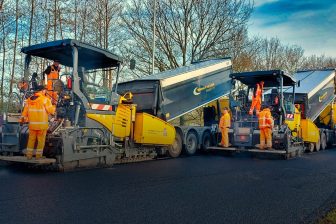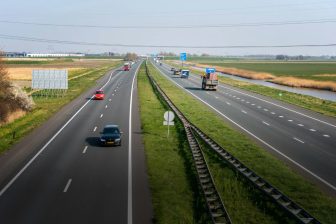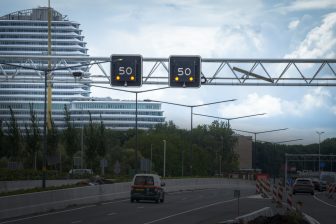Holcim: Successful start to the new year
Zurich, Switzerland – Successful start to the new year. Investments in India and China create new growth potential.
- Higher sales volumes across all segments
- Net sales up 70 percent to CHF 4.628 billion
- 52 percent rise in operating EBITDA to CHF 1.001 billion
- Operating profit advances 53 percent to CHF 627 million
- Net income jumps 70 percent to CHF 273 million
Group strength through global presence
All Group regions reported a very successful start to the 2006 financial
year. The global economy continued to expand at a favorable pace, thereby ensuring that demand for building materials also remained robust. Sales and quantities delivered rose in all segments. Sustained solid internal growth and the newly consolidated companies in the UK, the USA and India were responsible for this result.
Deliveries of cement were up by 24.7 percent year-on-year. Sales of
aggregates rose significantly, recording an impressive 89.6 percent
increase, and volumes of ready-mix concrete sold also achieved an
above-average increase of 44.4 percent. Thanks to Aggregate Industries
whose sales in the previous year were only incorporated into the
consolidated accounts as of April, both segments in Europe and North
America posted the strongest growth in percentage terms.
Consolidated net sales improved by 69.5 percent to CHF 4.628 billion. In
many markets Holcim was able to lift the prices of products. Combined with the consistent implementation of programs to enhance efficiency and control costs, the Group could absorb the effects of higher energy and transport prices. Operating EBITDA grew by 52.1 percent to CHF 1.001 billion. The Group achieved net income of CHF 273 million, which represents an increase of 69.6 percent. In the construction materials business, cash flow from operating activities is subject to considerable seasonal fluctuation. This was further influenced by the first-time consolidation of Aggregate Industries. Weather conditions mean that the construction business in general and road construction in particular is very weak in the first few months of the year in the UK and the northern part of the USA. Traditionally Aggregate Industries have low sales volumes at this time of the year. Consolidated cash flow from operating activities was therefore in negative territory at CHF 107 million (first quarter 2005: +77). On a like-for-like basis, cash flow increased by CHF 40 million to CHF 117 million.
Stronger demand for cement in Europe
In the first quarter of 2006, economic expansion in Group region Europe was very satisfactory. Although heavy winter snow at the start of the year
hindered construction activity in some market regions, virtually all
regional companies reported higher sales of cement, aggregates and
ready-mix concrete.
On the back of strong demand, sales volumes were solid in northern France and Switzerland. Thanks to an encouraging order book in the Hamburg region, Holcim Germany lifted sales of ready-mix concrete. At the same time, the company profited from cement exports to Aggregate Industries in the UK.
Allowing for the normally weak first quarter, Aggregate Industries recorded
gratifying volume growth in its home market in the United Kingdom. Demand
also held up well in central and southeastern Europe. In Croatia, Romania
and Bulgaria, the Group companies were able to increase deliveries in all
segments. Alpha Cement in Russia also showed a pleasing development.
Overall, cement sales in this Group region rose by 7.3 percent to 5.9
million tonnes. Special mention must be made of the increase in sales of
aggregates by 75 percent to 18.9 million tonnes and in sales of ready-mix
concrete by 41.4 percent to 4.1 million cubic meters. The strong upturn is
largely attributable to Aggregate Industries, whose results have been fully
consolidated since April 2005. In the first quarter of 2006, this company
alone posted sales in Europe of 6.7 million tonnes of aggregates, 0.6
million cubic meters of ready-mix concrete and 1.3 million tonnes of
asphalt.
Operating EBITDA increased by a strong 66.3 percent to CHF 291 million,
with internal operating EBITDA up by 28.6 percent. This success was mainly
due to first-time consolidation of Aggregate Industries. Also particularly
pleasing was the ongoing improvement in the performance of the Group
companies in France, Spain and Russia.
In the period under review, Group region Europe made consistent progress in
expanding its operating activities. The major project to increase clinker
capacity at the Beli Izvor works in Bulgaria is moving ahead according to
plan. In Romania, after the completion of the modernization of the Alesd
plant Holcim started work on the construction of a new kiln line at the
Campulung plant.
Dynamic construction activities in North America
The state of the North American construction industry remains very healthy.
Thanks to the mild, dry winter, in many places building sites were able to
work through the season without a break. This in turn generated additional
demand for building materials.
In the USA, the recovery in commercial and industrial construction
continues apace. The accelerated expansion and modernization of the
country’s transport infrastructure provided the main stimuli. In Canada
too, demand picked up in the construction sector in the second half of
2005. Housing construction was surprisingly buoyant, and the continuation
of various infrastructure projects helped to buttress the construction
cycle.
,br>
Holcim US and St. Lawrence Cement posted strong appreciable gains in cement
sales. At the same time, both companies were able to implement price
adjustments in several market regions. Consolidated cement sales in Group
region North America increased by 16.7 percent to 3.5 million tonnes.
The increase in sales volumes reflects the consolidation of the aggregate
and ready-mix concrete deliveries of Aggregate Industries US. In the first
quarter of the year, the new US Group company sold 7.1 million tonnes of
aggregates, 0.7 million cubic meters of ready-mix concrete and 0.5 million
tonnes of asphalt. Including the improved sales of the Canadian affiliate
in the respective segments, the consolidated sales volumes of aggregates
increased by 416.7 percent to 9.3 million tonnes and of ready-mix concrete
by 266.7 percent to 1.1 million cubic meters.
Thanks to the gratifying market development in North America, Holcim US and
St. Lawrence Cement reported considerably stronger earnings and improved
operating margins. However, Aggregate Industries always posts a loss in the
first quarter. On balance, consolidated operating EBITDA nevertheless
increased by a remarkable 79.1 percent to CHF 77 million. Internal
operating EBITDA growth in Group region North America reached an impressive
137.2 percent.
At the end of March civil construction started at the new cement plant at
Ste. Genevieve on the Mississippi. With an annual capacity of 4 million
tonnes of cement, this site will further strengthen the cost leadership
along the entire Mississippi-Missouri river system up to the Great Lakes as
from 2009.
Continued growth in Latin America
Despite variations between the local markets, Group region Latin America
has got off to a solid start in 2006. Oil-producing countries continued to
profit from high energy prices, which led to substantially higher public
earnings in Mexico, Ecuador and Venezuela. This favorable economic
environment has also had a positive influence on construction activity, in
particular private and public-sector housing and infrastructure projects.
Particularly Holcim Apasco in Mexico continued its robust performance of
the second half of 2005 into the present year. Active throughout Mexico,
this Group company recorded a strong advance in sales in all segments.
Group companies in Central America, Venezuela and Ecuador also posted solid
improvements in sales volumes. Cement sales of Holcim Colombia reached the
previous year’s record levels and prices improved. Holcim Brazil posted
higher sales in all segments on the back of a modest pick-up in economic
growth; however, prices are still under considerable pressure. Demand in
the Argentine and Chilean markets is holding up well, and the Group
companies Minetti and Cemento Polpaico delivered higher volumes of cement
and ready-mix concrete.
Consolidated cement sales in Group region Latin America advanced by 18.5
percent to 6.4 million tonnes. Sales of aggregates increased 10.7 percent
to 3.1 million tonnes, and deliveries of ready-mix concrete were up 26.3
percent to 2.4 million cubic meters. Holcim was able to sell substantially
higher volumes in Brazil and Mexico.
With a few exceptions, there has been a marked improvement in the results
of Group companies in Latin America. Holcim Apasco and Holcim Ecuador
recorded the strongest earnings growth. By contrast, Holcim Brazil had to
accept an erosion of margins in the face of unremitting price competition.
Despite this, operating EBITDA for Group region Latin America increased by
31.6 percent to CHF 329 million. The Group posted internal operating EBITDA
growth of 16.8 percent.
Solid development in Africa Middle East
The diverse Group region Africa Middle East experienced a good economic
environment in the first quarter of 2006. The construction industry
benefited from strong demand particularly in the countries along the North African coast and in South Africa.
The expansion of the transport and tourism infrastructure and the
construction of public housing had a positive effect on the cement sales of
Holcim Morocco and Egyptian Cement. Although the construction sector in
Lebanon stagnated, the local Group company sold more cement. Private
resellers continue to export cement, and Holcim Lebanon, too, was able to
increase sales to neighboring countries. The sales volumes of Group
companies in the Indian Ocean region also improved. Road and housing
construction were the prime drivers of growth on La Réunion. In Madagascar,
there was no sign of an end to the crisis in the building sector.
Construction activity picked up a little in West Africa. Although Holcim
South Africa’s sales were hit by heavy seasonal rainfall, delivery volumes
matched the previous year’s high levels.
On balance, cement sales in this Group region rose by 6.3 percent to 3.4
million tonnes. Aggregate and ready-mix concrete sales rose by 25 percent
to 2.5 million tonnes and 25 percent to 0.5 million cubic meters,
respectively.
In terms of profitability, Group region Africa Middle East achieved
substantially stronger results. Operating EBITDA increased by 18.9 percent
to CHF 151 million, while internal operating EBITDA growth was 14.2
percent.
In the period under review, Holcim established a foothold in the lucrative
building materials market of the United Arab Emirates (UAE). Holcim
acquired a 25 percent interest in Abu Dhabi-based National Cement Factory,
founded in 2005. The company has already started work on the construction
of a grinding station with an annual capacity of 2 million tonnes of
cement. This new plant is expected to come on stream in the second half of
2007 and will provide high-quality cement for the booming construction
market. Holcim has an option to increase its participation to 50 percent
after the first full year of operations.
The project to expand the capacity of the grinding station in Famagusta was
successfully completed. As a result, Holcim Lebanon can ship additional
quantities of clinker to northern Cyprus.
Robust building activity in Asia Pacific
In Group region Asia Pacific the construction sector posted a further
improvement in the first quarter of 2006. However, higher energy prices,
rising interest rates and local factors have had a moderating effect on
economic growth in some countries.
India, the Group’s newest market, continues to boom. Ambuja Cement Eastern
and since February first-time consolidated ACC Limited – formerly The
Associated Cement Companies Ltd. – both reported substantially higher
sales. Demand for building materials has been fueled by private and public
residential construction and major infrastructure projects. Cement sales
also rose in Sri Lanka and Bangladesh. In Thailand, Siam City Cement
managed to compensate for lower domestic sales with higher cement exports.
Group companies in Vietnam and Indonesia focused on higher-margin
deliveries and accepted a temporary decline in sales volumes. Thanks to the
boom in commercial construction and increasing infrastructure investment,
Cement Australia was able to match the high volumes achieved in the
year-ago period. Holcim New Zealand, however, reported a moderate decline
in volumes in all segments.
The marked expansion of 48.5 percent in cement sales to 10.1 million tonnes
is explained by the first-time consolidations in India. In the aggregates
segment, deliveries declined by 12.5 percent to 0.7 million tonnes. Sales
of ready-mix concrete increased, though. This is primarily the consequence
of enhanced vertical integration on the part of Siam City Cement in the
Bangkok region and the recent consolidation of ACC in India.
The Group’s operating EBITDA rose sharply by 85.5 percent to CHF 217
million. The significantly higher result mainly reflects the expanded scope
of consolidation and the good performance in India. The strong operating
improvements in Indonesia, Malaysia, Sri Lanka and Bangladesh were
compensated by a weaker demand in Australia and New Zealand as well as
higher distribution costs in Thailand and the Philippines. On a
like-for-like basis operating EBITDA was maintained on the previous year’s
first quarter level.
Consistent focus on sustained growth strategy
In the first quarter of 2006, Holcim maintained its consistent focus on its
global growth strategy by embarking on two important steps in its
expansion.
Thanks to the outstanding strategic partnership in India, Holcim was able
to acquire a substantial stake in Gujarat Ambuja Cements from the founder
families at the beginning of the year. This company operates mainly in the
North and West of the country and today owns 4 cement plants and 2 grinding
stations with a total capacity of 14 million tonnes of cement a year. In
the meantime, Holcim has a 14.8 percent stake in Gujarat Ambuja Cements.
Holcim is now participating in this dynamic growth market with a total
cement capacity of 34 million tonnes; an additional 4 million tonnes will
go on stream in the next 18 months.
Acquisition of a leading position in China
Parallel to the developments in India, Holcim has been given the
opportunity to acquire a majority shareholding in Huaxin Cement in China.
With a current annual capacity of 22 million tonnes of cement, Huaxin
Cement is one of the most progressive cement groups in the country. To
enable it to continue to participate in the dynamic growth of the Chinese
cement market, the Board of Directors of Huaxin Cement decided to increase
the company’s share capital through a private placement. Holcim will
acquire all of the newly created shares. The General Meeting of Huaxin
Cement already approved this private placement on April 7. On the
assumption that Holcim will also receive the necessary permissions from the
authorities, in the course of the year Holcim shall raise its participation
in Huaxin Cement to 50.3 percent.
Huaxin Cement’s home market is the Yangtze River Valley, particularly Hubei
province in central China, but also Jiangsu province and Shanghai. The
company’s modern production facilities include 7 cement factories and 5
grinding stations. By the end of 2007 Huaxin Cement will bring on stream
another 6 new kiln lines and an additional 3 grinding stations with a total
annual capacity of 14 million tonnes of cement. The group will then have an
overall capacity of 36 million tonnes.
Further growth in 2006
The building cycle is still intact, which will support demand in most
countries at the current high levels. Holcim continues to take steps to
enhance efficiency throughout the Group. Holcim’s very solid positioning
and the rapid integration of the recently acquired companies provide an
excellent foundation for generating further solid growth in the future. The
Board of Directors and Executive Committee expect a further improvement in
results in the current financial year. The forecasts published in March
2006 for the 2006 financial year still hold in all respects. Internal
operating EBITDA growth will be once again above the long-term average of 5
percent.
Key figures
Figures can be viewed at www.holcim.com
Holcim is one of the world’s leading suppliers of cement and aggregates
(crushed stone, sand and gravel) as well as downstream activities such as
ready-mix concrete and asphalt including services. The Group holds majority
and minority interests in more than 70 countries on all continents.
The first quarter interim report 2006 and results presentation can be downloaded from www.holcim.com/presentations
U las zojuist één van de gratis premium artikelen
Onbeperkt lezen? Profiteer nu van de introductieaanbieding voor € 10,- per maand.
Bent u al abonnee?



